Feature 008 • Feb 23rd 2020
- Images and words by Julia Fullerton-Batten
As a teenager I moved from Germany to live in Oxford on the banks of the River Thames. I grew up along the stretch of the river called Isis and since then the Thames has fascinated me. I now live in West London, still just a short walk from the river. Its constantly changing face, moving with the tide and the seasons and the activities that surround the river are an inspiration. But it is the history of the Thames and its stories that draw me in. These stories, countless whimsical, idiosyncratic and tragic happenings, all make up a history of one of the most important rivers in the world.
I am not alone in my admiration of the river. A constant inspiration to so many, there are more paintings of the Thames than I had ever imagined could be possible. Monet painted the river repeatedly. Turner captured the working river revealing the early nineteenth century fumes and smoke plumes from the city’s factories and river traffic. In the 1860s and 70s Whistler was drawn to paint the bustling and rapidly changing urban neighbourhoods close to the river. When one views all these works, it is not difficult to understand why they sought inspiration along its shores.
In my project Old Man Thames, I set forth investigating cultural and historical narratives that have occurred along the river and have translated several of these stories into photographs and a short film. These wonderful stories of life and living, of challenge and heartache and of hope and death all exist along the shores of the Thames.
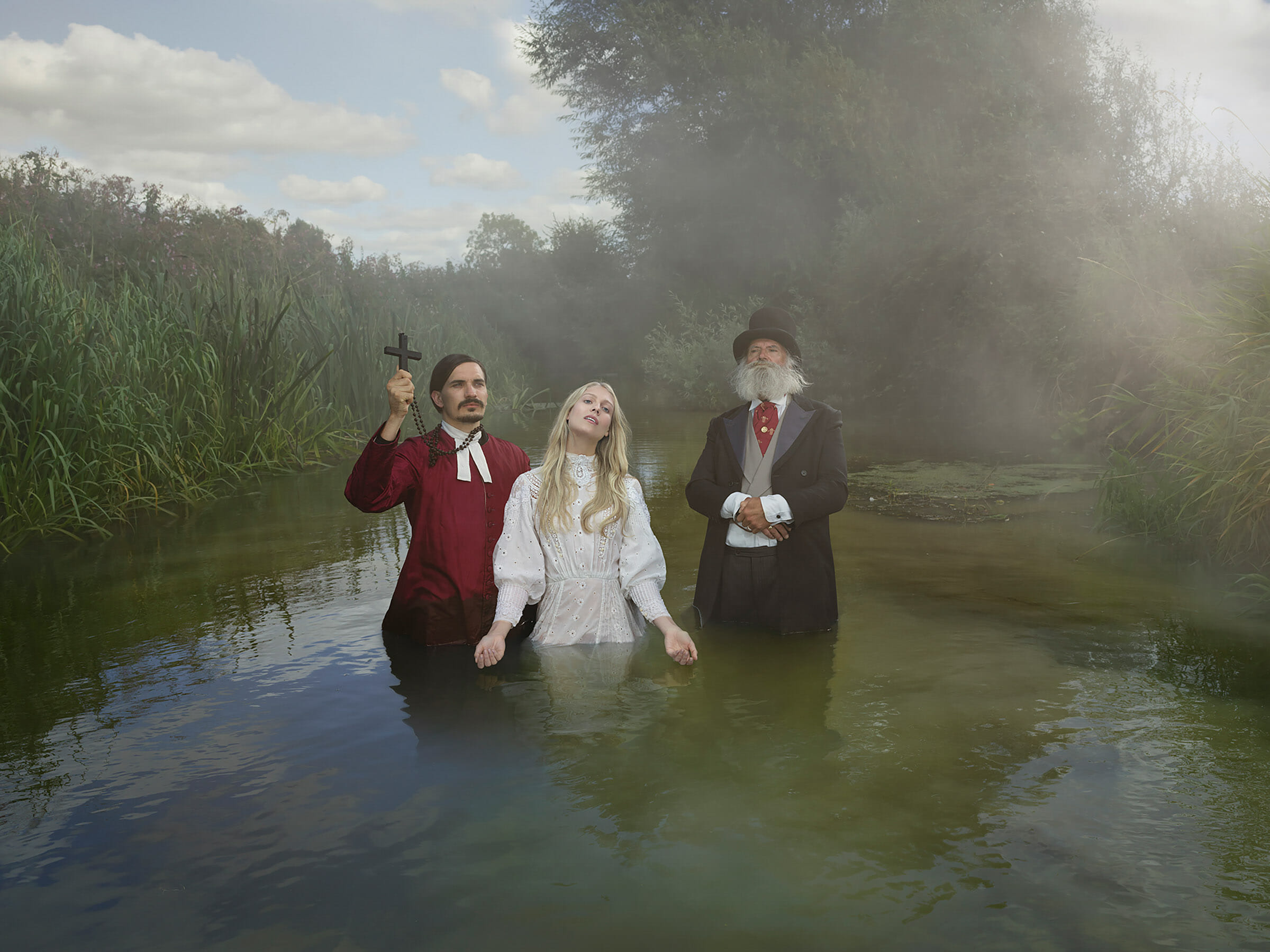
Baptisms along the Thames
Baptism is an important act in the affirmation of faith, and is done before a group of people who witness the their confession of faith in Jesus Christ. It is the rite in the Christian Church by which immersion in water symbolizes the washing away of sins and admission into the Church. For many centuries full immersion baptisms were performed by Baptists in the non-tidal section of the River Thames, upstream from London. It was one of the more ancient rituals on the river. Several hundred people would congregate to watch the open-air ceremony. My photograph was taken in the ancient town of Cricklade in Wiltshire, 100 miles outside of London, where the ceremonies have taken place in an area known as Hatchett’s Ford since the beginning of the twentieth century.
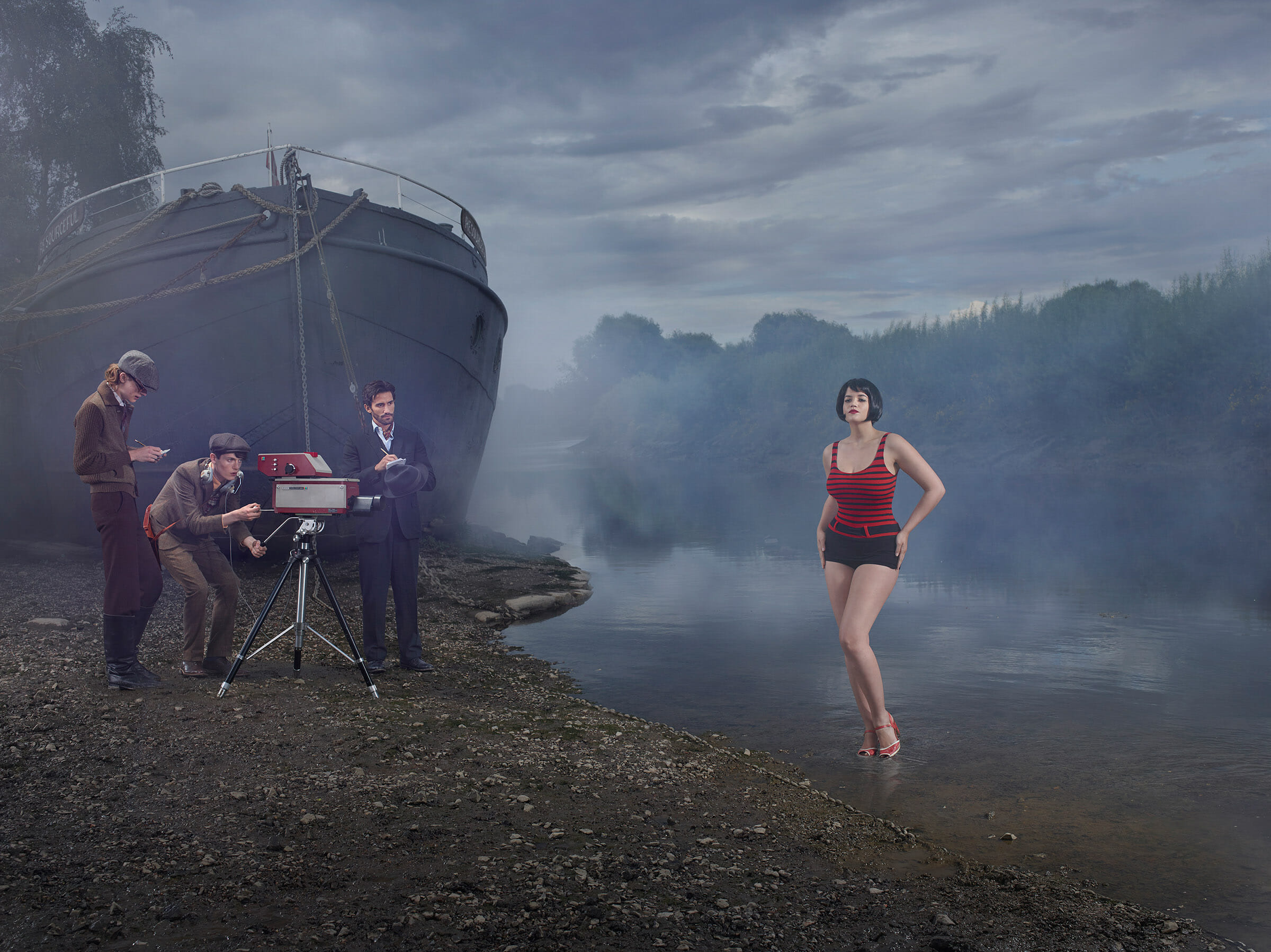
Annette Kellerman – Swam the River Thames
Annette Kellerman was an Australian professional swimmer, vaudeville star, film actress, writer, and business owner. She arrived in the UK in 1905 at 19 years old with the goal to swim the English Channel. She failed three times. However, Kellerman became the first woman ever to swim any distance on the Thames. She swam from Putney to Blackwall, a distance of 27km. On these occasions she wore a one-piece bathing suit that she had self-designed. This was very daring and controversial as, at that time, women still wore bloomers and long sleeve dresses. Her daring apparel was duly noted and became headlines in the UK press. Two years later she was arrested in America for indecency, as she continued her fight for the right of women to wear a fitted one-piece bathing suit above the knee.
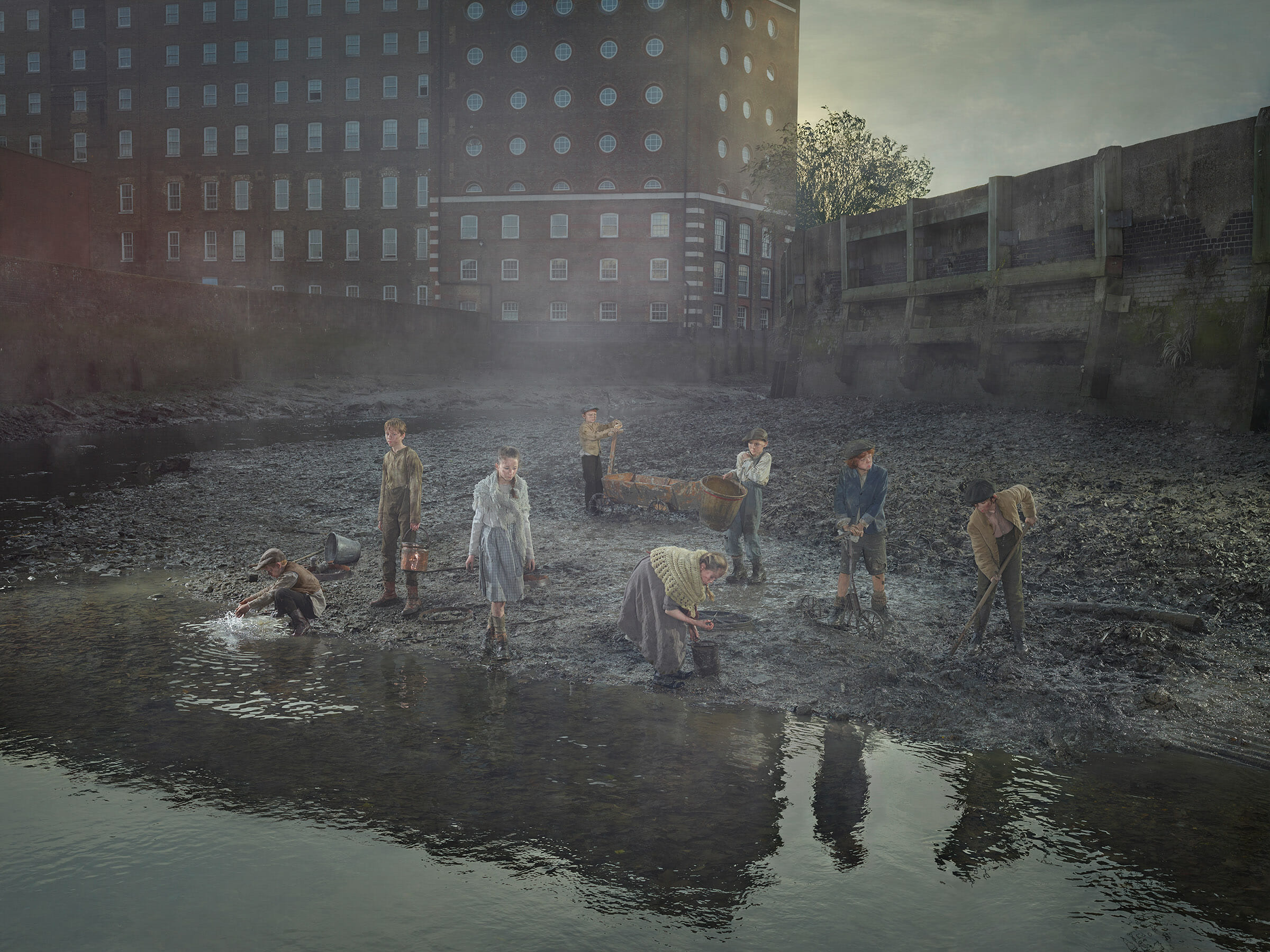
Children – Mudlarks
In Victorian times, along Thames at low tide, it was a common sight to see groups of dirty, ill-clad, barefoot young boys and the occasional girl foraging on the muddy, slippery foreshore of the river. Moving on calloused feet they scavenged for anything brought up by the tide that they could sell. They were aptly named, Mudlarks. Their booty might be merely wood, coal, rope and bones, but, if they were lucky, they could find something of higher value, perhaps buttons, coins, objects of historical value, and very occasionally, precious metal items. They belonged to the poorest among society, maybe homeless orphans or children of large, destitute families. Sometimes the Mudlarks were joined by the elderly, or the penniless, hoping to find enough to pay for a small meal or for alcohol.
Mudlarks were still active on the Thames until early in the 20th century. Even today, Mudlarks explore the muddy, shoe-sucking shores of the Thames. Better clothed, well shod and using metal-detectors and other sophisticated equipment to help them make their finds.
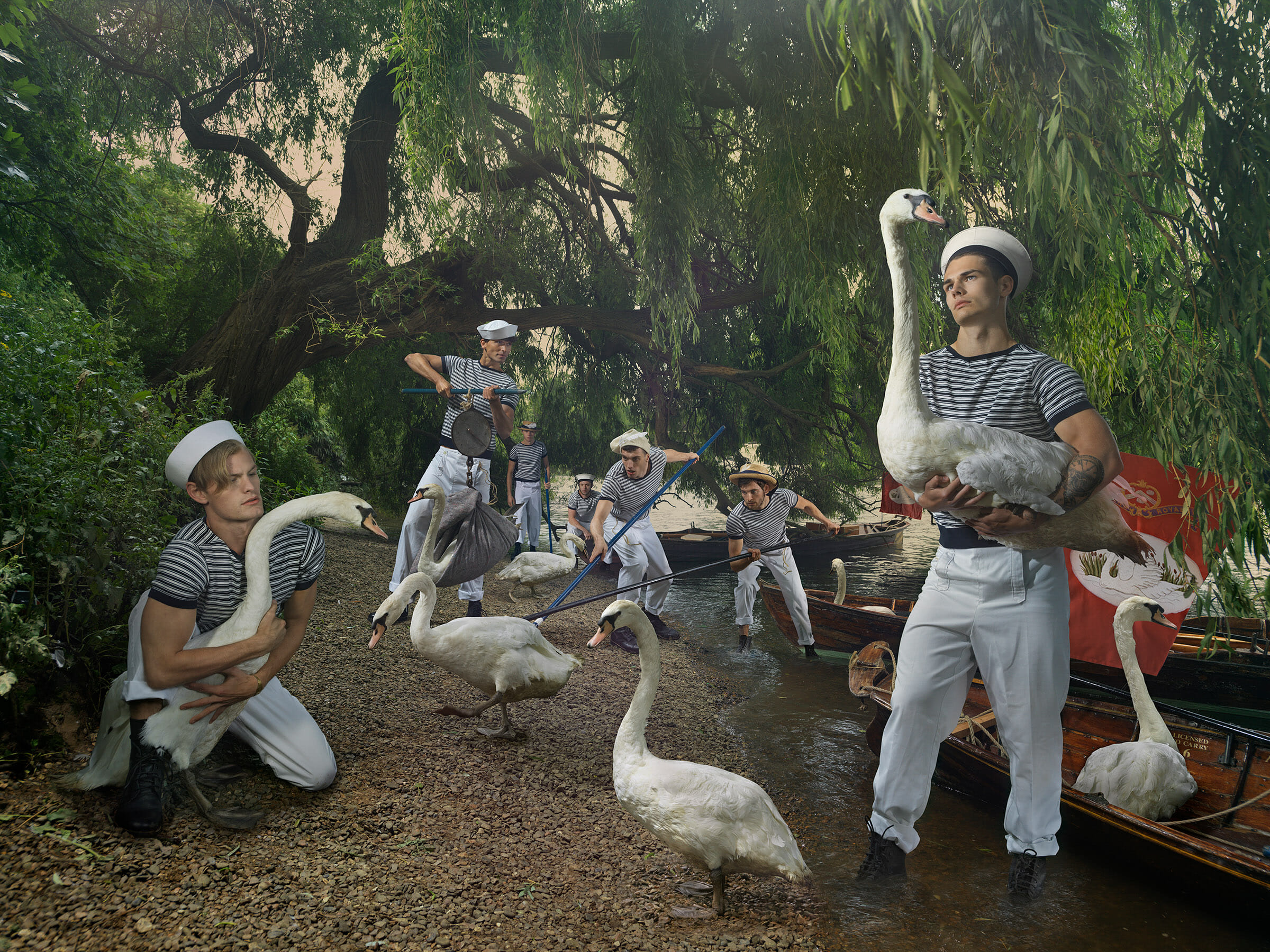
Swan Upping
Swan Upping became important back in the Middle Ages in Britain. Back then, not only was the mute swan a valuable commodity and regularly traded between noblemen, but swan owners were legally bound by the Crown to mark their swans with nicks in their beaks. This activity took place annually in a ceremony called “swan upping”. Although now largely symbolic, the event still takes place today on the Monday of the third week in July, and serves to monitor the condition and number of swans on the Thames. The year’s new cygnets can be marked when they are reasonably well grown but cannot yet fly.
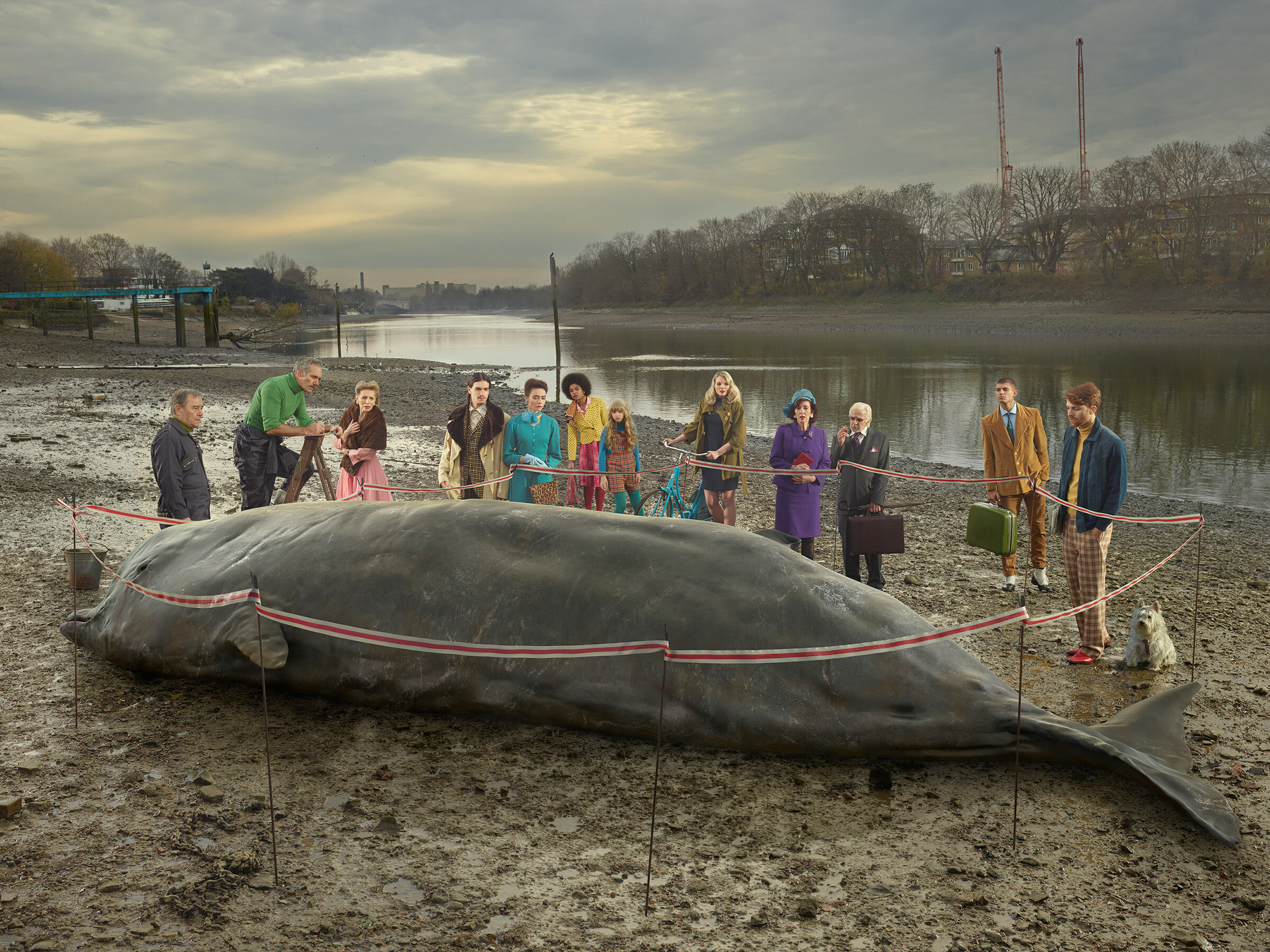
The Thames Whale
In January 2006, a juvenile female northern bottlenose whale was found swimming in the River Thames in central London. Approximately five metres long, she weighed about seven tonnes. Her normal habitat would have been along the coast of the far north of Scotland and Northern Ireland, or in the Arctic Ocean. It was the first time since records began in 1913, a whale had ever been seen in the River Thames. Sadly, the whale died the next day from a seizure as she was being rescued. Her skeleton is now exhibited at the Natural History Museum.
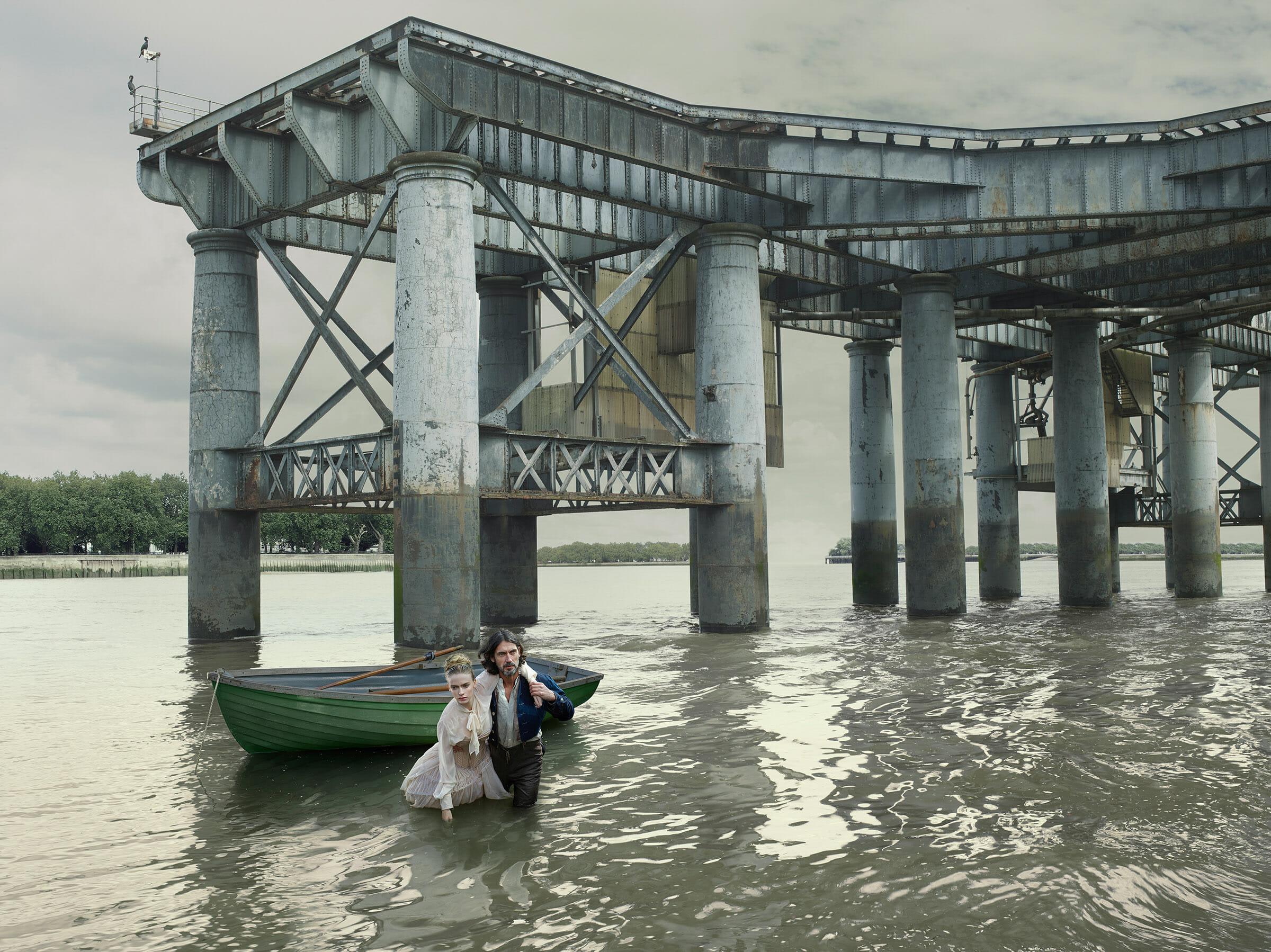
Suicide attempt by Mary Wollstonecraft
Mary Wollstonecraft (1759 – 1797), born in Spitalfields in the east of London, was a famous English writer, philosopher and advocate for women’s rights. Today her life and work are regarded as influential in the formation of the feminist movement.
She lived her adult life to the fullest and was known to have many ill-fated affairs, and a daughter by one of her lovers. She became pregnant again from a passionate relationship with the philosopher William Godwin. She married him in 1797, but died eleven days after giving birth to a second daughter. She was 38.
After her death, Godwin published a Memoir (1798) of Wollstonecraft’s life, revealing her unconventional life and loves. He described that she had attempted suicide twice. She took poison for her first attempt, but her second attempt was much more melodramatic. In October 1795, upon learning about the infidelity of her current lover, Wollstonecraft decided to commit suicide by jumping from Putney Bridge. She went out on a rainy night and walked up and down for some time “to make her clothes heavy with water”, then jumped into Thames. However, a boatman had seen her fall and rescued her in dramatic fashion.

Sweet Message in a Bottle
Married with a baby daughter, Private Thomas Hughes boarded a troopship in September 1914 to go to fight the Germans with the Third Army Corp Expeditionary Force. Some whim encouraged him to write a message to his young wife and place it in a green ginger beer bottle with a screw-on rubber stopper, then throw it into the sea. He died two days later. His final words remained unread until 1999, 85 years later, when fisherman Steve Gowan scooped the bottle up in his net as he fished for cod in the Thames Estuary off the Essex coast. The note was still dry and intact.
The message read: “Dear Wife, I am writing this note on this boat and dropping it into the sea just to see if it will reach you. . . . . Ta ta sweet, for the present. Your Hubby.” He also wrote a covering letter: “Sir or madam, youth or maid, would you kindly forward the enclosed letter and earn the blessing of a poor British soldier on his way to the front this ninth day of September,1914. Signed Private T. Hughes, Second Durham Light Infantry.”
Private Hughes’s wife, Elizabeth, had died in 1979, but their 86-year-old daughter, Emily, pleaded with Mr. Gowan to return the letter to her. She was only two years old when she last saw her father as he headed off to battle in 1914. Emily’s daughter, Elizabeth, commented: “It is too late for the letter to be opened by the person it was intended for, but the next best thing is for it to be handed to his daughter. It’s incredible that something lying on the seabed for almost a century has survived intact for so long”.
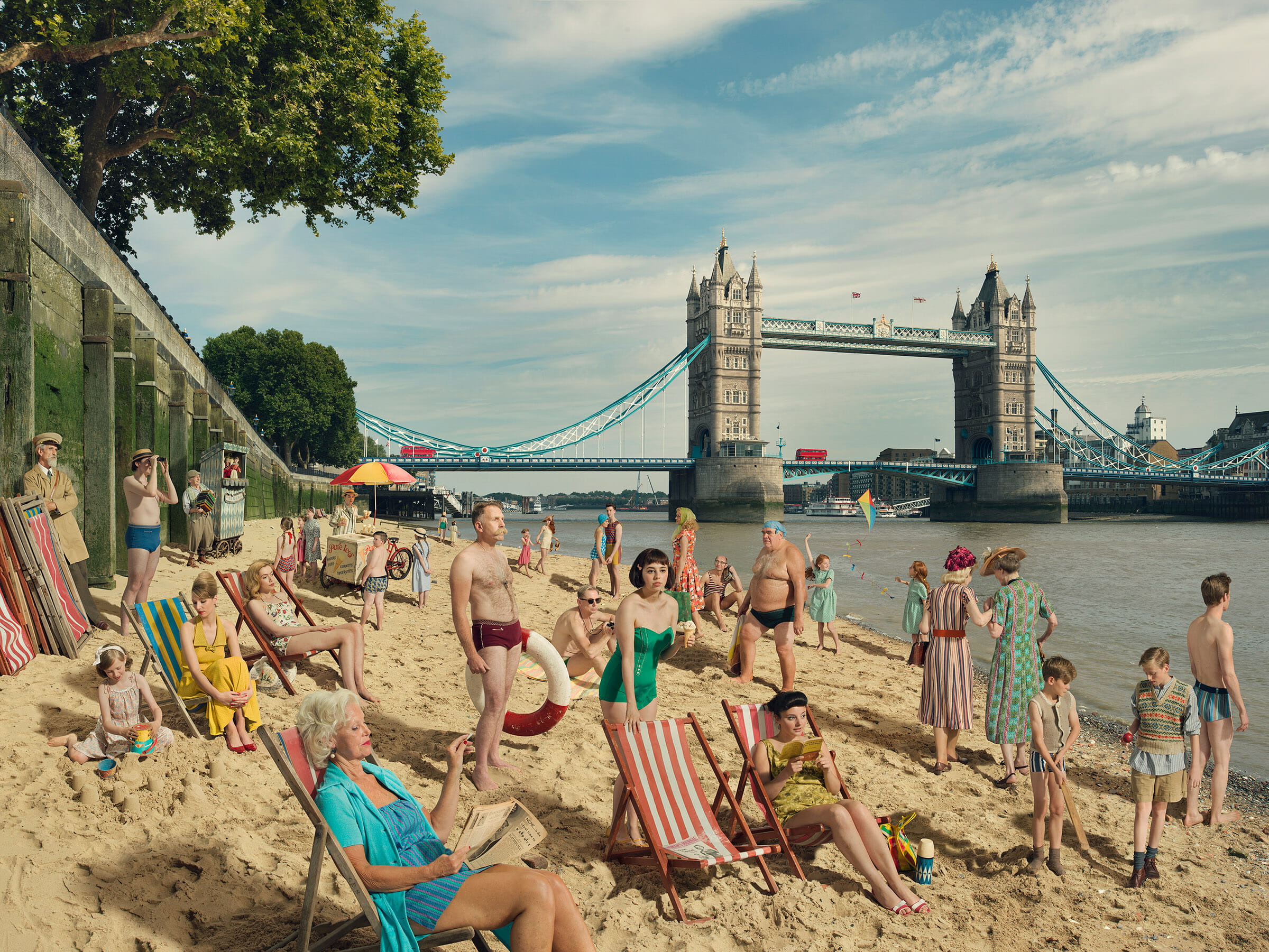
Bathers at Tower Bridge
Standing today in the shadow of Tower Bridge, one of the most iconic of London’s bridges, we would never consider that, in the 18th Century, the area was once a popular bathing spot for all classes of society, foremost, women and their children escaping the claustrophobia of crowded dwellings in Central and the East End of London. Of course, it was only possible to bathe or sun-bathe for short periods of time as high tide on the Thames was every 3 – 4 hours, making it unsafe to do so. Indecency laws prohibiting bathing were introduced in 1815, as men had started bathing in the nude.
Tower Beach, as it was called, was used for paddling, sun-bathing and swimming from 1934 to 1971, but poor water quality once again forced closure. However, the improved quality of water in the Thames may soon mean bathing will be possible again.
I chose to profile the 1950s era in my image, photographing women and children in vintage one-piece swimwear and period dresses; the men in the shot were going about their daily business against the iconic background of the Thames and Tower Bridge. Interposed are some of the entertainments of the day, Punch and Judy shows, donkey rides, and fast food on offer, ice-cream and hot dog stalls. Most of the stalls and equipment were designed to facilitate a hasty retreat from the artificially prepared beach as the tide began to rise.
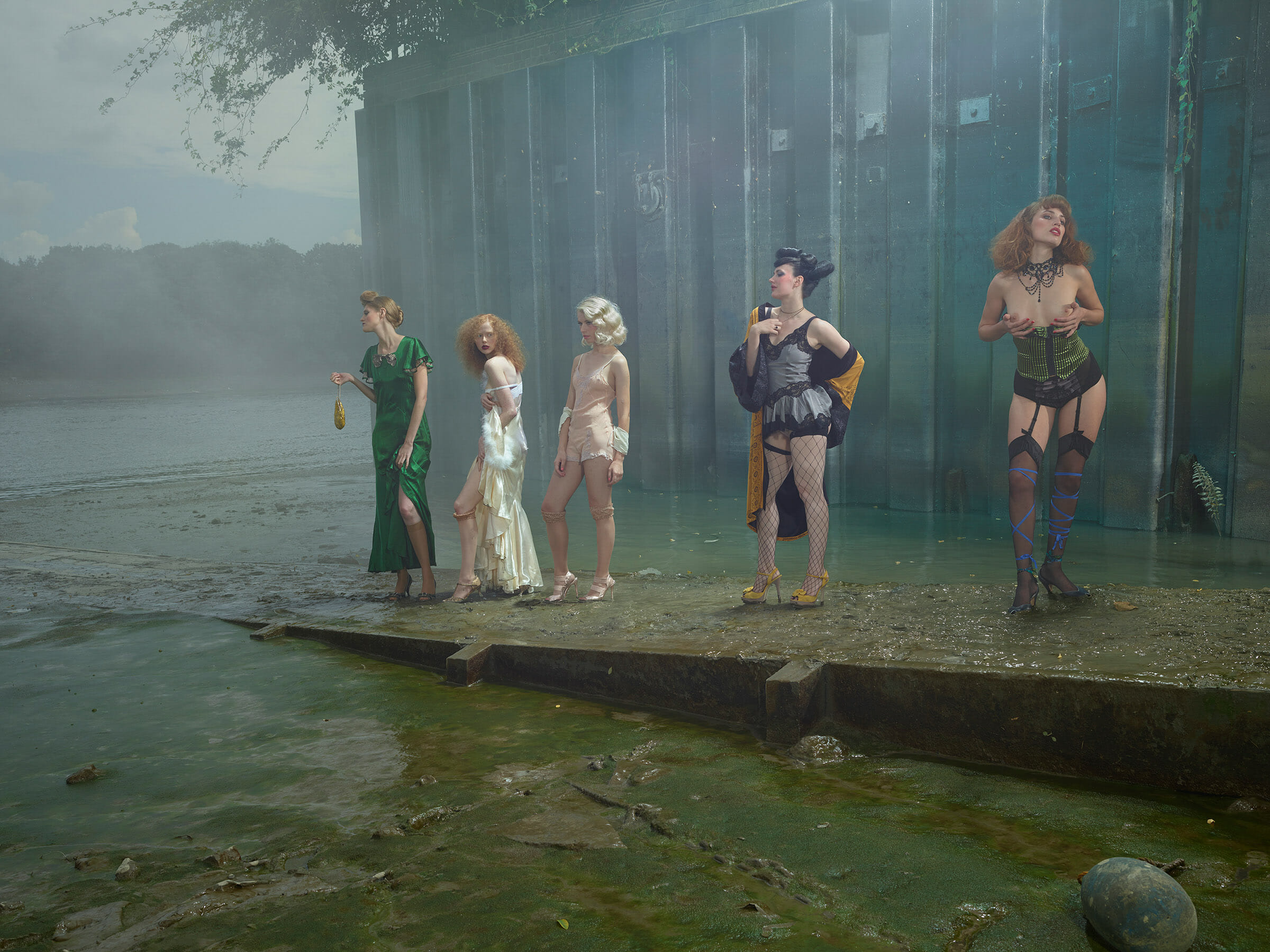
Slut’s Hole
Slut’s Hole was the name given in the12th Century to a row of ancient tumbledown cottages nestled against the south wall of the churchyard of St Nicholas Church in Chiswick, then a small village on the boundary of London. The street lead to a ferry landing which was then, the only crossing point for miles. The inhabitants of the street were fishermen, watermen, and small traders; their families lived in extreme poverty. Although the street was named ‘Slut’s Hole’, with obvious inferences according to modern-day terminology, it is suggested that the name was derived from the ancient word for ‘sluice’.
Today, Chiswick is a leafy suburb in the west of London. Unsurprisingly, the street has long since been renamed as Fisherman’s Place, but the name ‘Slut’s Hole’ still reverberates in the folklore and history of Chiswick, raising the question of the origin of such an audacious name. There are many anecdotal indications that the old cottages truly did harbour local ladies fighting against their poverty by providing carnal pleasures to travellers crossing the river by ferry. I wondered how the whores made a living and thought of passing kings and bishops on their way to Hampton Court. The Thames being the main thoroughfare from Tudor times onwards.
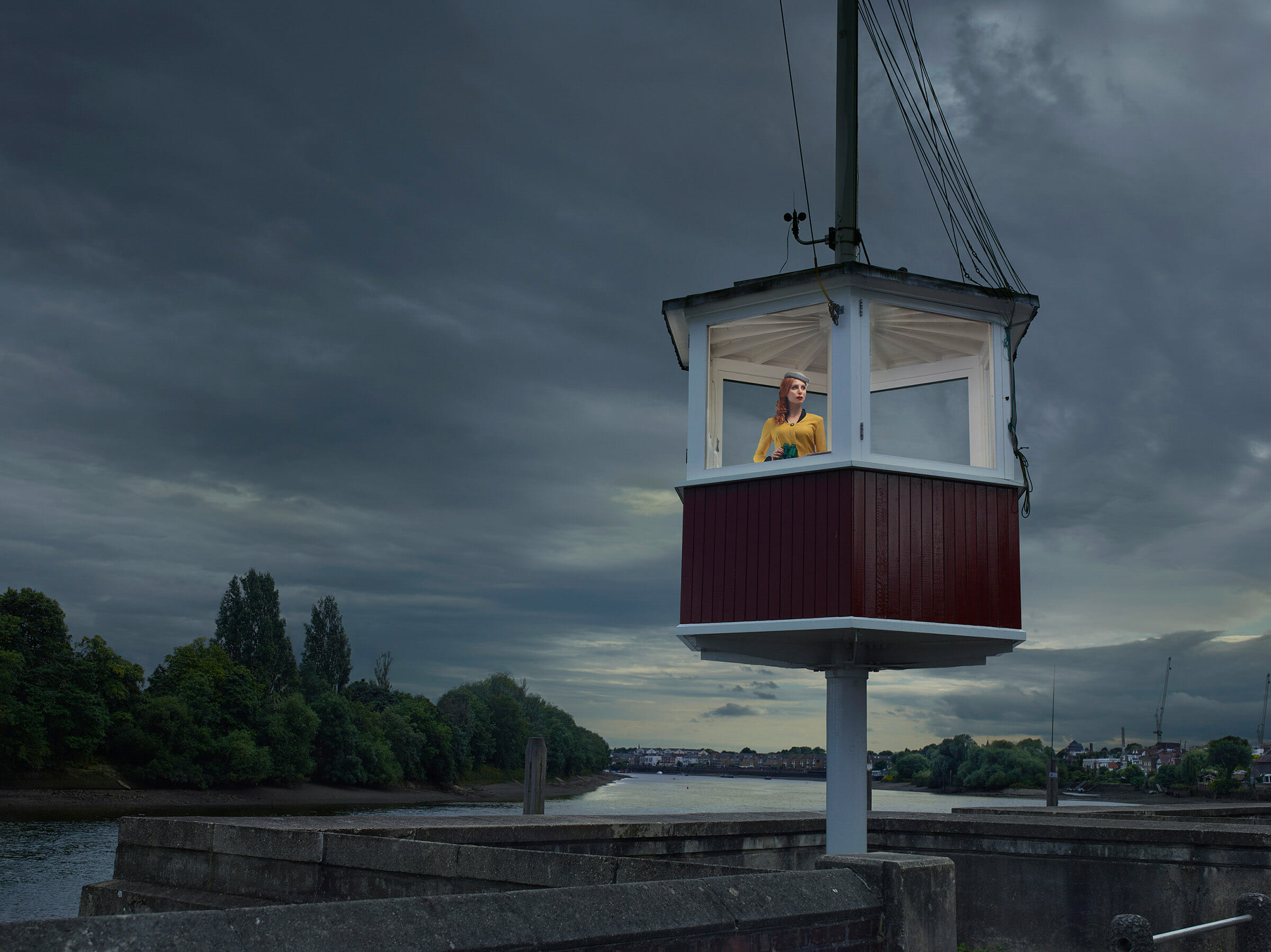
The Race Box
The River Thames is a favoured location for internationally renowned boat races, not only the annual University Boat Race between Oxford and Cambridge, but also The Great River Race, over 21.6 miles from the London Docklands to Ham in Surrey. This race annually attracts several hundred crews from all over the globe. Yachting and rowing clubs line the banks of the river. Every day of the week and especially on weekends, yachtsmen and rowers can be seen enjoying their hobby, whatever the weather.
One such club, the London Corinthian Sailing Club was forced to relocate its clubhouse in the 1960s after its previous clubhouse was deemed unsafe having suffering severe bomb damage from a V-1 flying bomb during WW II. The clubhouse had to be demolished and the club moved a mere 200 metres upstream. The new clubhouse, called Linden House, a gracious refurbished Georgian building in the grounds of which an award-winning race officer’s starting box was installed next to the river. From this elevated position yacht racing officials and the occasional guest, have a clear uninterrupted view along the entire racecourse.
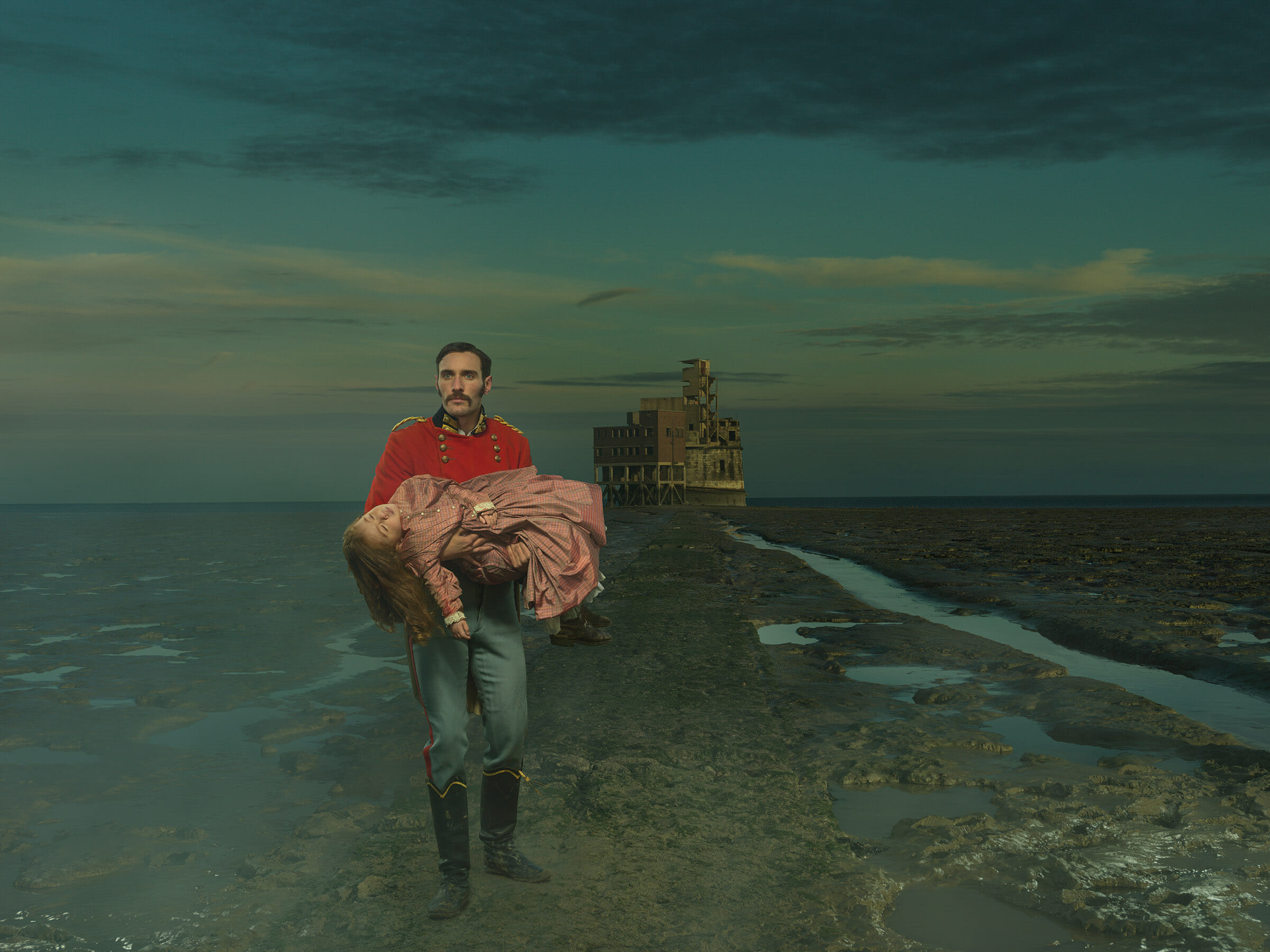
The Grain Tower
The Grain Tower is an off-shore fort that was built in the middle of the 19th Century to protect the River Thames from invasion by the French navy. Standing 600 metres out to sea, it can only be reached a high tide by boat or at low-tide by a causeway. The tower was initially oval and three stories high, with 3.6 metre thick walls. It was named after the next nearest town of Grain in Kenta and was manned by a gun crew with barracks, storehouse and officer’s quarters. Internal gangways connected various parts of the building.
My story involves a report in The Times newspaper of 23rd May 1867, which reported that Marie Eugenie, the youngest daughter of Captain E. F. S. Lloyd of the Royal Engineers had died at the Grain Tower. We can assume that he was the commanding officer at the time, also that his wife and daughter were residing in the barracks. Marie Eugenie may have fallen sick from tuberculosis, then a very common cause of death, or experienced a fatal accident. In my image we see the disconsolate father carrying the body of his precious daughter across the causeway to her burial place on the mainland, in Grain.
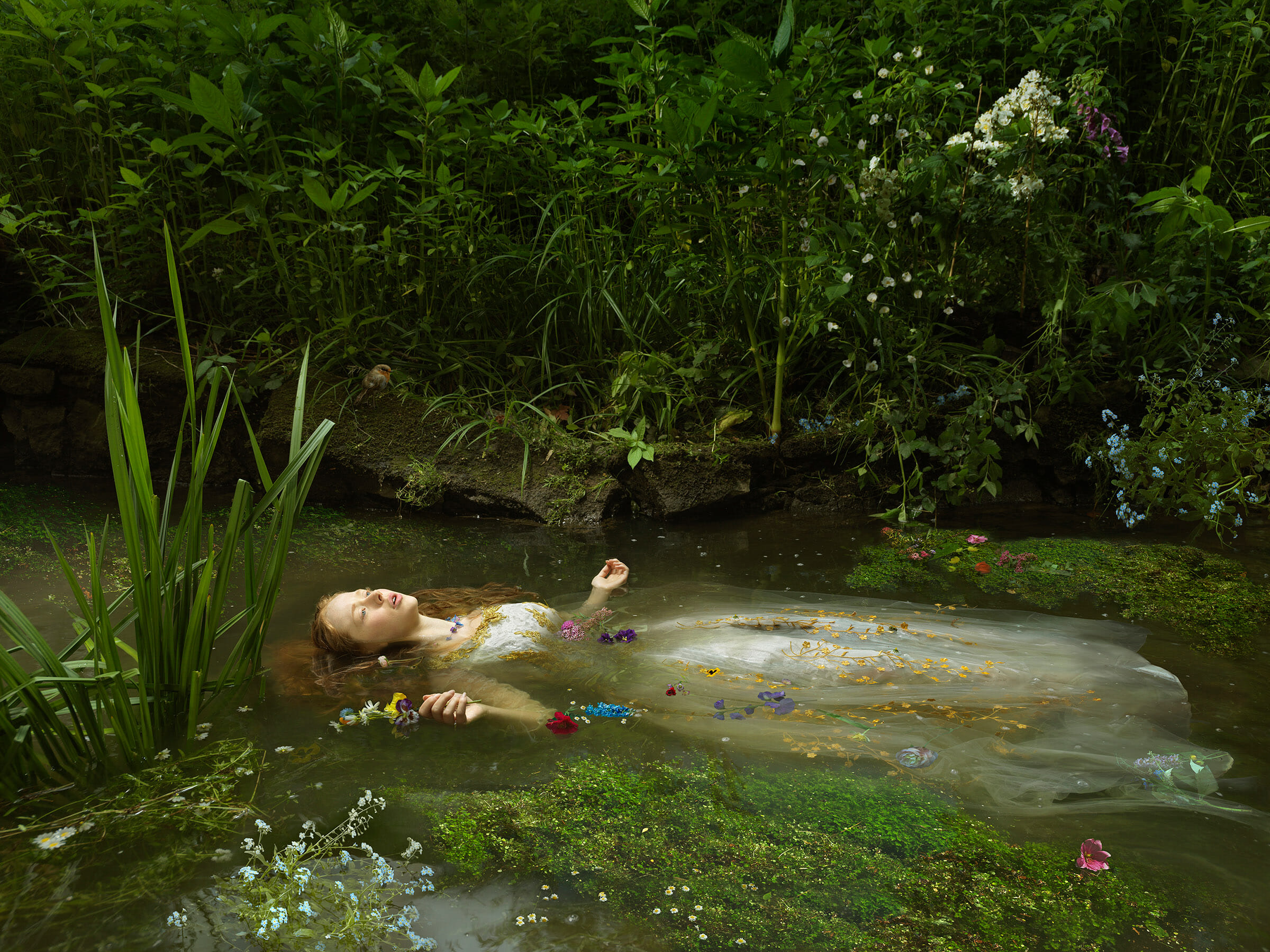
Ophelia
John Everett Millais’ famous painting of Shakespeare’s Ophelia, hanging in the Tate Gallery, London, has long been one of my favourite works of art. Ophelia was a noble woman in Shakespeare’s play Hamlet. She was frustrated in her love of Hamlet. The painting shows the beautiful and vulnerable Ophelia lying on her back in a stream after falling from a tree, still clutching flowers that she had just collected. She was singing, unaware of her eminent pending doom. Air trapped in her clothing kept her afloat until they were saturated, and she drowned.
It is well known that Millais created the painting in two stages. The first stage in 1851 was to paint the background, using the Hogsmill River at Ewell in Surrey as his location. The second stage in 1852 was to paint in Ophelia, using Elizabeth Siddal (‘Lizzie’) as his model. She had been a milliner and was only 19 years old when discovered by the Pre-Raphaelites, who appreciated her unique beauty. She sat for several of them before Millais hired her for his painting of the second part of his Ophelia project.
During preparatory researches for my ‘Thames’ project I was delighted to discover that Hogsmill River is a tributary of the Thames. I decided that this justified including the very moving story of the creation of Millais painting in the project. I was aware that several other photographers had shot versions of the Ophelia painting. Although I decided to shoot the scene in its entirety, I otherwise wanted to make my image as authentic to the actual creation of Millais’ painting as possible. With the help of the vicar of the local Baptist Church, who knew the details of Millais’ stay in the locality, I was able to shoot the scene at the exact spot where he created the first part of his painting in 1851. Furthermore, recognising their importance to the interpretation of the content of the painting I replicated in my image every single flower present in the painting. In addition, I ensured that my model had similar features, hair and skin colouring to those of Lizzie. I dressed her in an antique dress onto which my stylist handstitched the gold applique to replicate the dress she wore in the painting.
For his second stage of the painting Millais’ had Lizzie lie fully dressed in a water-filled bathtub. Now winter time he kept the water warm with oil lamps placed under the tub. Once, pre-occupied with his work, he let the oil lamps go out. Lizzie lay acquiescent in the increasingly colder water for several hours, afterwards she became very ill and was sickly for the rest of her short life. To ease her health problems she took laudanum, an opiate, and became addicted to it. She experienced a long and turbulent relationship with another famous Pre-Raphaelite painter, Dante Gabriel Rossetti before marrying him and bearing a still-born baby daughter. Depressed, she died from an overdose of laudanum, at 33. What a tragic coincidence that Lizzie’s death in real life eventually mirrored the fictional fate of Ophelia!
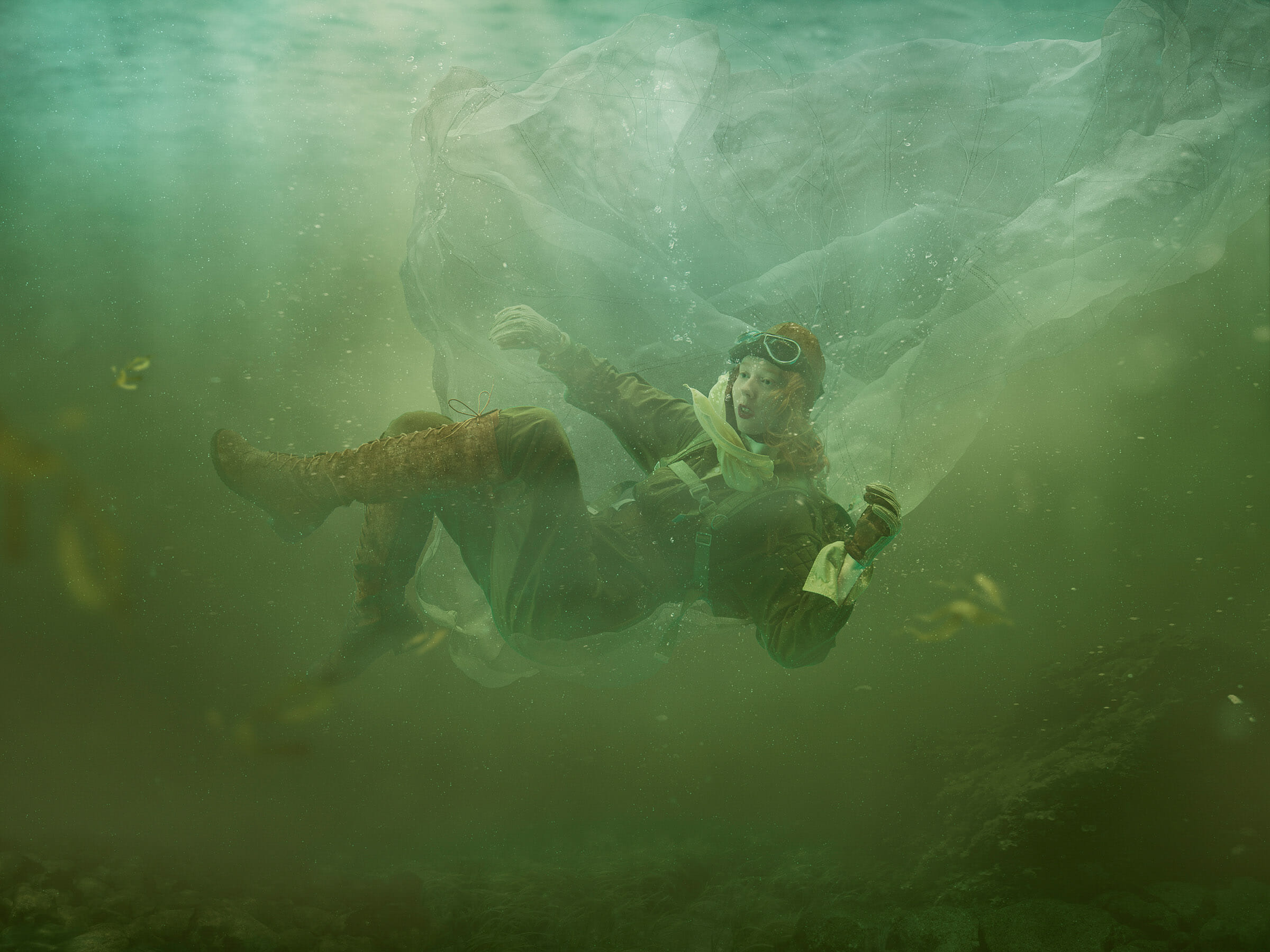
Amy Johnson
Amy Johnson gained worldwide recognition and became the heroine of the British population, especially among women, when in 1930 at 27, she became the first female pilot to fly solo from Britain to Australia. Her plane was a second-hand de Havilland Gipsy Moth bi-plane. She named it Jason. It now hangs in the Science Museum in London. She subsequently set records for flights to Moscow, New York and Tokyo, and survived several crash landings in doing so. As well as gaining her incredible pilot credentials, she graduated from Sheffield University with a Bachelor Degree in Economics.
In 1940, at the outbreak of WW II, with 164 other female pilots, she signed up with the newly formed Air Transport Auxiliary (ATA). Their job was to ferry military aircraft, fighters and bombers, single-handedly to various RAF bases around the country.
My image illustrates the tragic death of this remarkable woman. She lost her way flying a plane in bad weather from the North of England to a base near Oxford. She had to bail out of her plane when it ran out of fuel over the Thames Estuary. A minesweeper close by saw her enter the rough sea on her parachute and attempted to rescue her. The boat’s commandant jumped overboard, but was unsuccessful. He died two days later from hypothermia. Amy’s body was never found.

Escaping the Flood
Flooding has occurred along the River Thames for millennia. As the size of London and its population grew, the effects of flooding grew more intense, causing considerable damage to homes and land. High walls, now called The Embankment, were built along the banks of the river in London in the 18th Century, but flooding still occurred. Only when the Thames Barrier became operational in 1982 could the potential for floods reaching London be successfully controlled.
In the first half of the 20th Century flooding happened with such regularity that people living on low-lying land along the banks of the Thames developed a very stoic attitude towards the flooding. Black and white photographs from that time pictured people escaping from the upper windows of their homes, walking on a raised pathway of wooden planks, rowing boats or paddling improvised craft down flooded streets.
My image shows two elegantly dressed ladies poling their way through deep water, perched precariously on a door they had wrenched off its hinges. A little girl sitting in a galvanised bathtub accompanies them. They have rescued their pet rabbit and carry it with them in a birdcage, the only receptacle they could find in their haste. A suitcase contains a few clothes for a few nights stay in drier accommodations. In the background, the river has claimed a prestigious victim as a rather expensive, locally parked car idly bobs up and down, partially submerged in the flood.
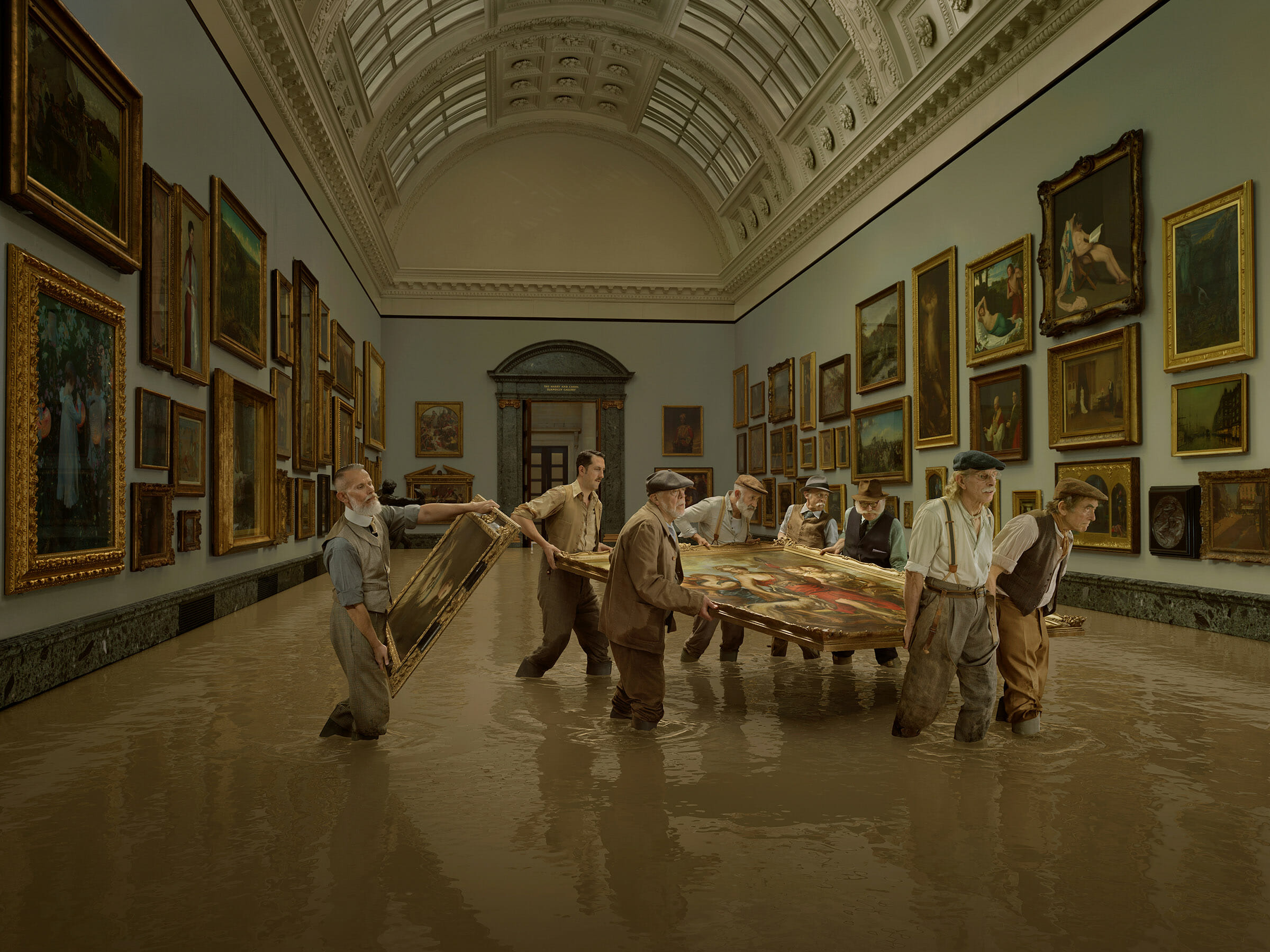
1928 Flooding of the Tate Gallery
The Thames becomes tidal a few miles upstream from London. The difference in water level between low and high tide is 7 metres at London Bridge. In the past, flooding occurred regularly when strong winds blew a tidal surge up the river from the Thames Estuary, coincided with inland flood water.
The Embankments were built along the banks of the river in London in the mid-18th Century to prevent flooding in low lying parts of the city. But one fateful day in January 1928 unfavourable elements coincided. The river rose rapidly to the highest level ever measured, causing the Embankments to be breached. In the ensuing flood fourteen people died, thousands were made homeless, and business life was severely affected. After the flood receded, many buildings were condemned and demolished.
The world-famous Tate Gallery with its walls full of priceless paintings was one of the buildings that had flooded. The basement flooded to a depth of about 8 feet (2.4m). Paintings were damaged, including many valuable sketches and watercolours by Turner, one of Britain’s most prestigious artists.
My image captures the aftermath of the flood in the Tate Gallery. A massive wet painting is carried by a group of porters to safety. Paintings were allowed to dry naturally and then restored. Miraculously, despite their emersion in muddy Thames water for several hours, only eighteen paintings were damaged beyond repair. Even more amazing was that the Turner watercolours had not run. In 2011, 80 years after the flood, John Martin’s “Pompeii” could finally be fully restored and re-hung.
Another massive flood in 1953 killed over 300 people on the East Coast and along the lower reaches of the Thames. It was decided to build a flood defence mechanism that would stop dangerous tidal surges from reaching London. The Thames Barrier was finished in 1984 and has worked successfully ever since.
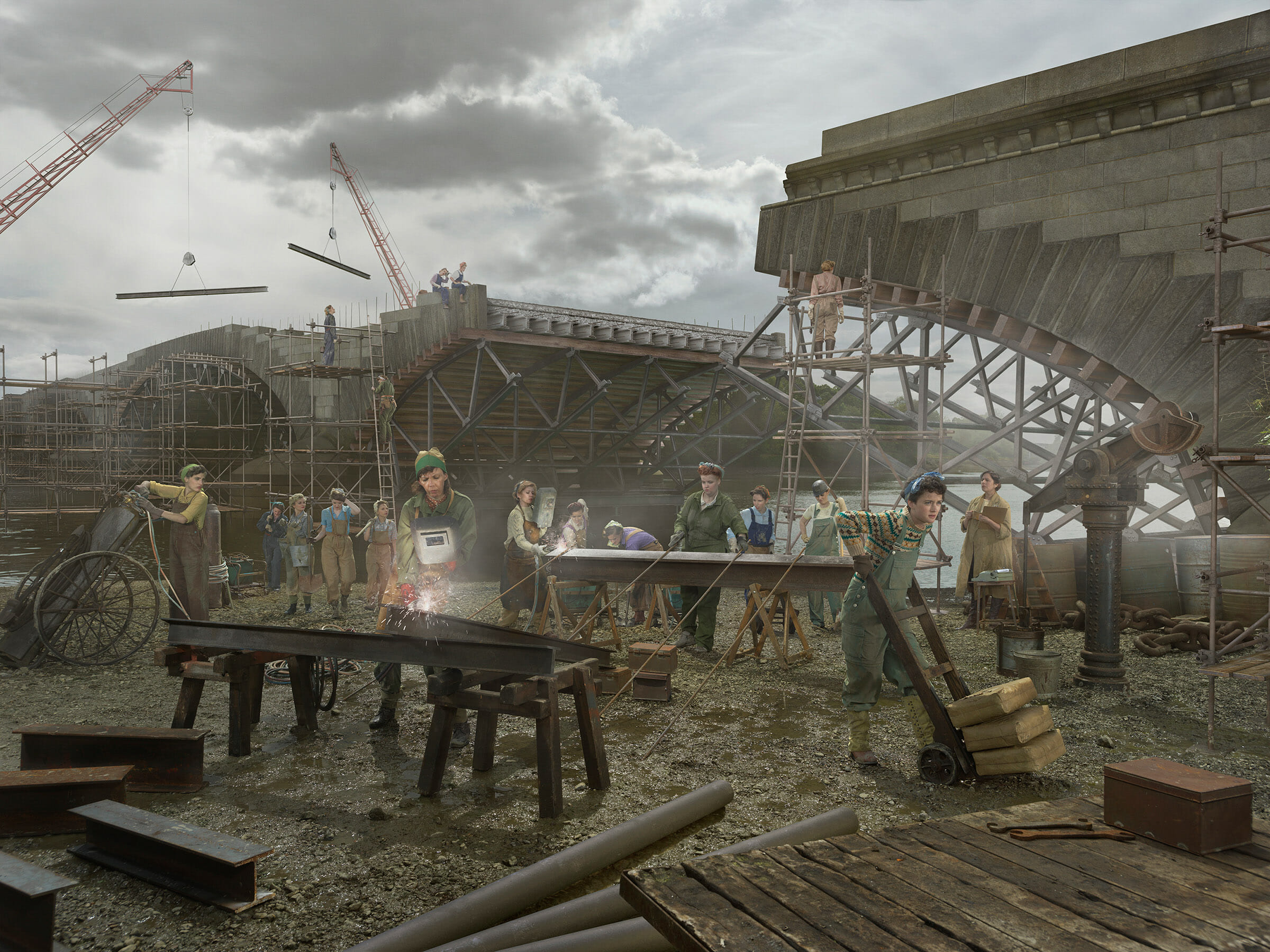
The Ladies’ Bridge
They built a bridge. Not just an ordinary bridge, but the sleek and elegant Waterloo Bridge spanning the River Thames in London. Who were they? The clue lies in the alternative name for Waterloo Bridge – the ‘Ladies’ Bridge’, the folklore name given to it by the riverboat guides daily plying the Thames. As they approach the bridge the guides explain to their eager listeners that Waterloo Bridge was completed during WWII by hundreds of women who left doing their daily chores at home, or other jobs, to work on the bridge as welders, joiners, stonemasons and labourers.
Building work had begun on the bridge in 1939 with about 500 male workmen. War broke out and gradually most of them were enlisted to fight. By 1941 only 50 men remained. Completing the bridge was a priority and it was completed, somehow. The bridge was opened to traffic and pedestrians in 1942. For over 70 years the details of its completion remained hazy. The Labour politician Herbert Morrisson said to the crowds gathered at the official opening ceremony that finally took place in December 1945: ‘The men who built Waterloo Bridge are fortunate men. They know that, although their names may be forgotten, their work will be a pride and use to London for many generations to come.’ Apparently only the riverboat guides knew the real story and in their minds, Waterloo Bridge was ‘The Ladies Bridge’ because they knew who had built it.
Only very recently, did historian, Christine Wall, research the story behind the strange name. She discovered archived photographs showing women welders and labourers working on the bridge and interviewed eye-witnesses who attested to this almost forgotten part of London’s history. Working together with filmmaker, Karen Livesey, they made a video about the women workers, ‘The Ladies’ Bridge’ (http://www.theladiesbridge.co.uk/). The story began to unfold.
The Waterloo Bridge we see and use today is the second bridge built across the Thames on this site. The first was completed in 1817 and was named after the famous victory at the Battle of Waterloo (1815). Built during the era of horse-drawn carriages, it was unsuitable for carrying motor vehicles and it was demolished in 1934. Taking its place, is the graceful “Ladies Bridge”. Without their loudspeakers and the Londoners’ wit of the riverboat guides, the truth about its creation during the Blitz years would possibly never have been known and the story of the forgotten heroines of London’s “Ladies’ Bridge” can now be celebrated.
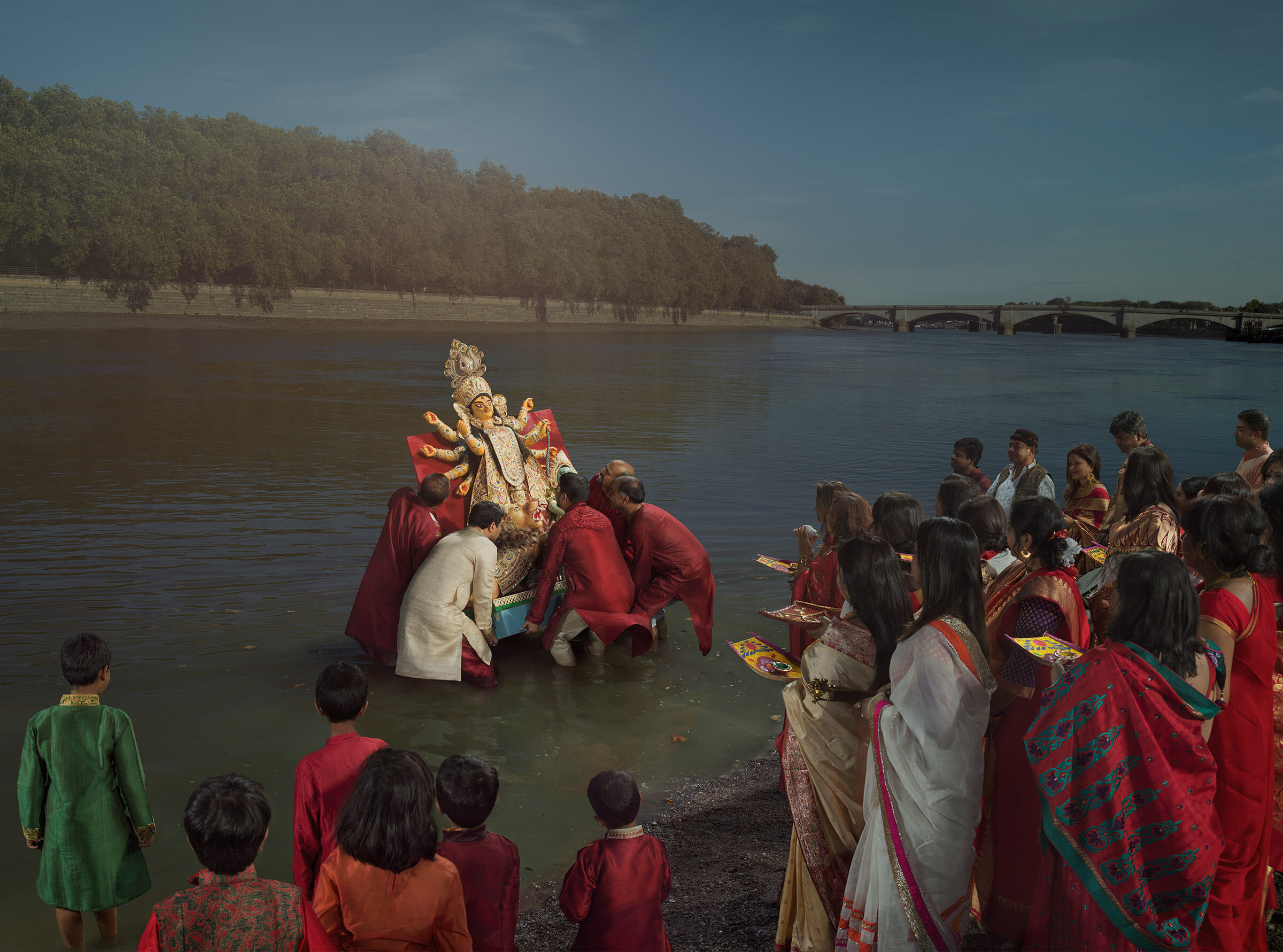
Bengali Durga Immersion (‘bhashaan’)
Multiculturalism is very pronounced in the UK. People from many nations have brought their own religions, customs and cultures into the country and practice them, especially in London. One event encompassing all these facets is the ceremony of Durga Puja. This is a 5-day celebration of Durga, one of the most popular of the Hindu faith’s many deities. Durga is shown as a warrior goddess riding a lion, or a tiger with eight or ten hands holding weapons and making symbolic hand gestures. Her mythology centres around combating evil and forces that threaten peace, prosperity and the karma of the good. She is the embodiment of feminine and creative energy (Shakti).
Durga Puja is celebrated throughout the world by Hindus annually in September or October. During the festival, Hindus commemorate Durga’s victory over evil with prayers and readings, decorations in temples and homes, and events recounting Durga’s legend. In India and especially in West Bengal, the festival (‘puja’) always concludes with the immersion of an effigy of Durga into a river or any other body of water. This age-old ritual bids farewell to Durga, as she returns to her husband and children in their spiritual home.
Durga Puja is celebrated enthusiastically wherever Bengalis have cast their roots. For health and safety considerations Bengalis living in London have only infrequently been permitted to perform the immersion ceremony on the banks of the River Thames. In 2018, thanks to the cooperation of the Bengali charity organisation, London Sharad Utsav, and by special permission of the Port of London Authorities, I was able to shoot a recreation of this Bengali ‘bhashaan’ceremony on the banks of the Thames close to Putney Bridge.
My image shows the ten-armed, beautifully decorated effigy of Durga being ceremoniously carried into the river by a selected group of men as the crowd on the bank watch and chant the farewell ‘asche bochor abar hobe’ (until next year). The women are colourfully dressed in traditional laal-paar saris and the men in their equally traditional and colourful kurta. The effigy was built 10 years ago by London Sharad Utsav specially for the Durga Puja celebrations and shows Durga riding a lion and holding a weapon in each hand. For the past decade during Durga Puja, the idol could only be worshipped indoors in Ealing Town Hall. This year it could fulfil its rightful role in this recreated ‘mock-up’ immersion ceremony.
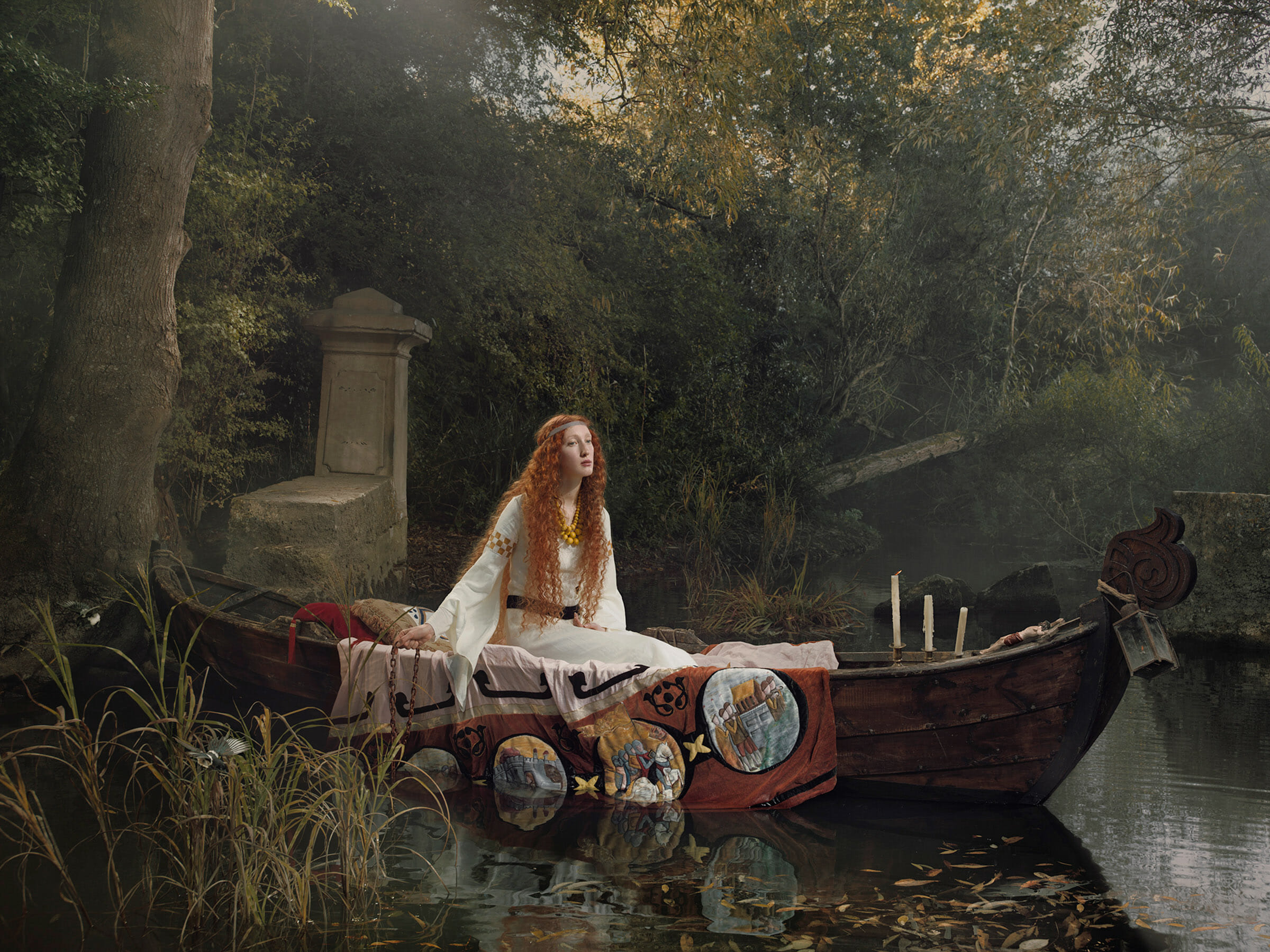
The Lady of Shalott
The famous English poet Alfred, Lord Tennyson first published ‘The Lady of Shalott’ in 1832, a poem based on one of the legends surrounding King Arthur and his knights of the Round Table. In his poem ‘The Lady’ lives isolated in a tower on an island called Shalott close to Camelot, King Arthur’s palace. She bore the curse that if ever she looked at Camelot from her window she would be punished. Her only view of the outside world was its reflection in a mirror. Courious, one day she stole a look and the mirror shattered. Bewitched by what she had seen she climbed out of the tower window, took to a boat, and floated down the Thames River in the direction of Camelot.
On the bank of the river, she sees Sir Lancelot, one of King Arthur’s knights, and instantly falls in love with him. But he does not see her and cannot return her feelings. She dies before reaching Camelot where Lancelot finally sees her – but only as a corpse.
My image is based on the famous 1888 painting made by the Pre-Raphaelite artist John William Waterhouse, ‘The Lady of Shalott’. He portrays ‘The Lady’ as she sits in the boat as a sorrowful maiden dressed in virginal white. He heightens her sensuality with bright red lips, long flowing hair, and a low-slung sash. She has just cast off from the island, the mooring chain is still in her hand, a crucifix lies near the bow of the boat and three nearby candles suggest her spirituality. But only one of the candles remains lit, a portend of the fateful future awaiting her. The tapestry that drags in the water is one that she had woven on her loom during her lonely days in the tower.
Waterhouse painted three different versions of The Lady of Shalott. It is believed that his wife modelled for this one.

The Frost Fair of 1814
With our present concerns about global warming, it may be a surprise to many to learn that the northern hemisphere was in the grip of a ‘Little Ice Age’ between the 17th century and early 19th century. During this period the River Thames froze over in twenty-four winters. On six occasions beginning in 1608 and ending in 1814, the ice was thick enough for Londoners to set up tents and hold the famous Frost Fairs.
It was apparent that the construction of the ‘Old’ London Bridge was a root cause for the build-up of ice as its many narrow arches reduced the flow of water and ice was more prone to form. When the bridge was demolished in 1831 and replaced by the ‘New’ London Bridge it was built with much wider arches. Combined with other changes made to prevent freezing of the tidal part of the River Thames, freezing became a thing of the past and the Frost Fair of 1814 was the last fair Londoners have experienced.
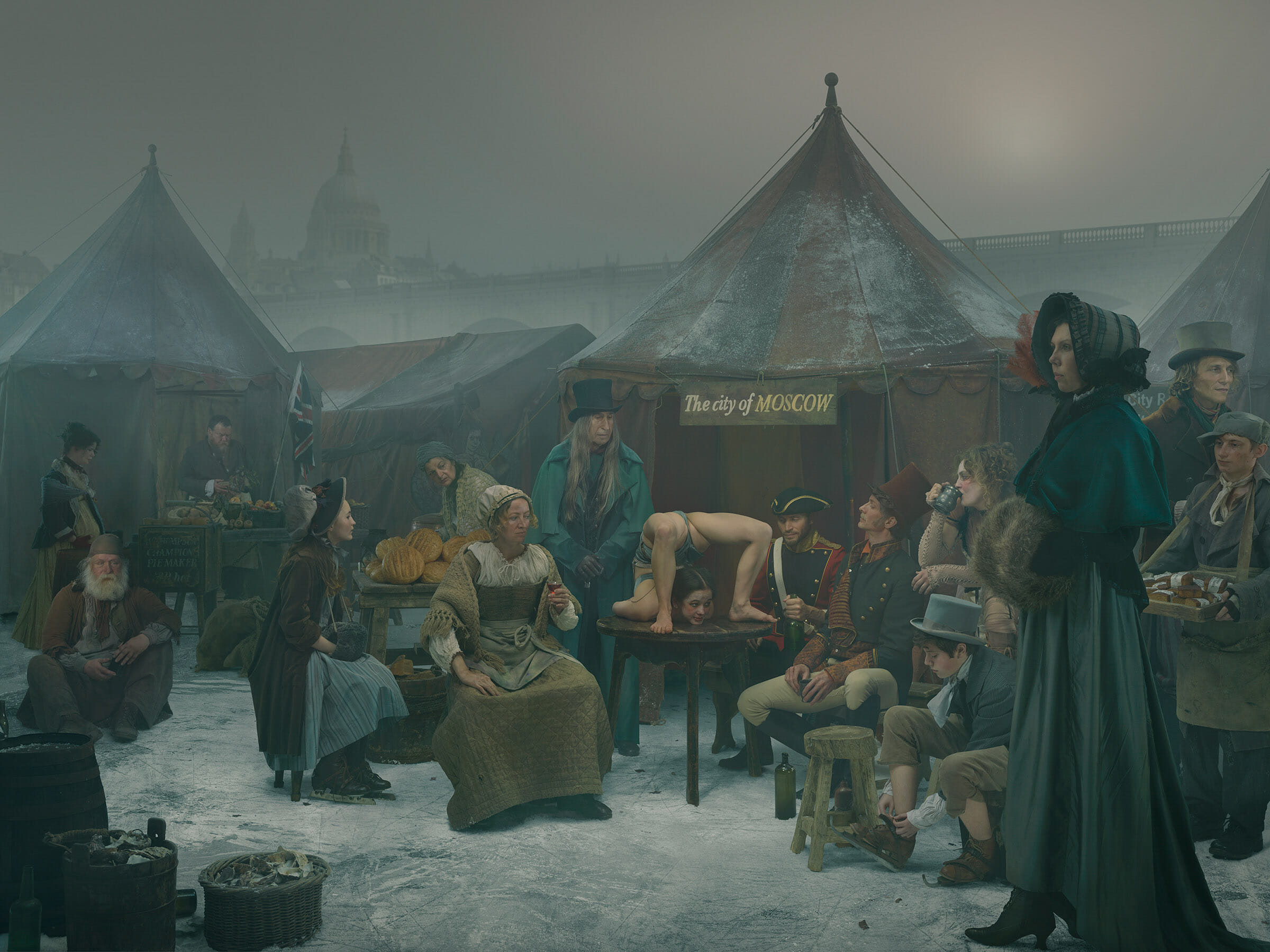
Over a period stretching from the end of December 1813 to the end of January 1814, the ice build-up became thick enough for people to skate or sledge across the river from one riverbank to the other. Unable to ply their trade, the watermen demanded a toll for letting people onto the ice.
Knowing the history of prior Frost Fairs, London tradespeople soon set up make shift tents which they decorated with ‘flags of all nations, streamers and signs’. A street called ‘City Road’ was created. All kinds of entertainment were offered. The most startling event was when an African elephant was led across the frozen Thames close to Blackfriars Bridge.
Over the next four days until a gradual thaw set in, Londoners flocked onto the frozen river to enjoy the party. Kitchens and furnaces were set up offering food and, of course, gin and beer were plentiful. Pickpockets, gamblers and prostitutes all did a roaring trade, especially as visitors became more drunk. Some paid to have the watermen escort them off the ice again, especially as the ice was not entirely safe in places. In fact, it was recorded that three men broke through the ice, disappeared from sight and were presumably drowned in the freezing water.

Julia Fullerton-Batten
Hyper-realism and cinematic are characteristic descriptions of Julia Fullerton-Batten’s images. They are often set in unexpectedly surreal settings with dramatic lighting, communicating simultaneously both tension and mystery. Her latest project is a series of images inspired by her fascination with the River Thames and celebrates ‘the glories of the river’ against a backdrop of historical ad traditional events, anecdotes and legends. Her works are in the collections of the National Portrait Gallery in London, UK and the Musée de l’Elysée in Lausanne, Switzerland.
Thames & Hudson used one of her images for the front cover of their publication A Guide to Collecting Contemporary Photography